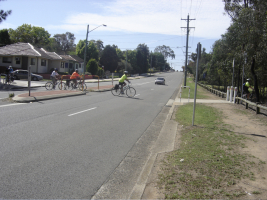When an Overpass is Not Justified

You’re cycling along a wonderful piece of off-road cycleway with a handful of kids, and without warning you are confronted by every parents nightmare: a road crossing. It wasn’t marked on your path map, the traffic seems to be coming in a continuous stream from both directions, the kids are reluctant to take a risk and slightly scared; and the seconds turn into minutes as your group fails to cross. Finally someone jumps through a looming gap in the cars, Mum’s heart skips a beat, a motorist slows kindly, and the group escapes to the safety of the other side and the continuation of the path.
It only takes one such incident for Mum to call a stop to those lovely weekend morning rides. The local council and the RTA still call this an off-road cycle path, but in essence you need a great deal of road skill to safely negotiate one of these crossings. On our growing network of paths there are hundreds of these crossings. Some call them ‘level’ crossings, I call them ‘conflict’ crossings as it’s a place where motorists and off-road cyclists come into conflict.
As yet I haven’t seen any council or state road authority properly find an answer the problem. What do you do when an overpass (or underpass) is not justified? Is a set of traffic lights the only other option? And do cyclists really want traffic lights? At dawn on a weekend these crossings are no obstacle at all yet in peak hour they can be impossible to cross. As cyclists we have to face the fact that an overpass costs many hundreds of thousands of dollars, and while the RTA seems to take the attitude that overpasses or traffic lights are the only option for 6 lane highways; we are not going to get them built across even secondary roads, let alone minor ones. In some cases even traffic lights don’t seem to be justifiable anyway.
Some motorists even stop and give way to groups containing kids, maybe they are mothers too, or just cyclists at heart. But what does this teach the kids, when legally here they have no right of way? What happens next time when the motorist is not so kind and the child believes they can cross in front of the cars?
It’s unfair to expect a motorist to give way to a cyclist coming down the path at 35 kph at right angles to the road, they simply can’t react to a cyclist coming in that direction, and often the sight lines are blocked by trees and fences.
Similarly, it’s unfair to expect all cyclists, particularly children, to give way to cars and trucks. An environment is created where a small error can result in death. This in turn leads to high reluctance to take any risk in crossing, and a reluctance to use the path at all. Bring on the Playstation, it’s safer! Yet this is the direction that many road authorities are taking. On the Orphan School Creek route from Abbotsbury to Prariewood there are 10 of these crossings in a distance of only 7 kilometres. One of these, Smithfield Road, is quite a major road.
In a different area, another crossing, of Pitt Street, between Merrylands and Parramatta, requires the cyclist to cross a 4 lane road whilst giving way to the road traffic. The road comes down a steep hill in both directions so traffic is not travelling slowly at all. The speed limit at both of these spots is 60 kph.
I try never to argue an issue without proposing a solution, so here it is. A high tech solution is movement activated traffic lights, which sense the approaching cyclist and switch the traffic lights on and they turn red to stop the cars. The system would count the cyclists onto and off the crossing and switch the traffic lights off again when the cyclists clear the crossing. Cheaper would be a button about 20 metres up the cycle path for cyclists to push as they arrived to trigger the crossing, and an exit button for the last cyclist to switch the lights back off. Cyclists would need to pass at moderate speed to avoid having to stop and wait.
A cheaper and simpler solution is for these crossings to be shared zones and signposted as such for both cars and bikes, with a speed limit for all road users of, say, 20 kph. In a shared zone, nobody has right of way and both types of traffic have a responsibility to avoid accidents. This is a simple traffic control concept of bringing both sets of conflicting users to the same speed to minimise the effect of a collision. Signposting should be something like “Cyclist crossing SHARED ZONE Speed limit 20 kph”. I expect that some sort of legislation would be required to enable police to enforce the 20 kph as a speed limit, similar to school zones.
